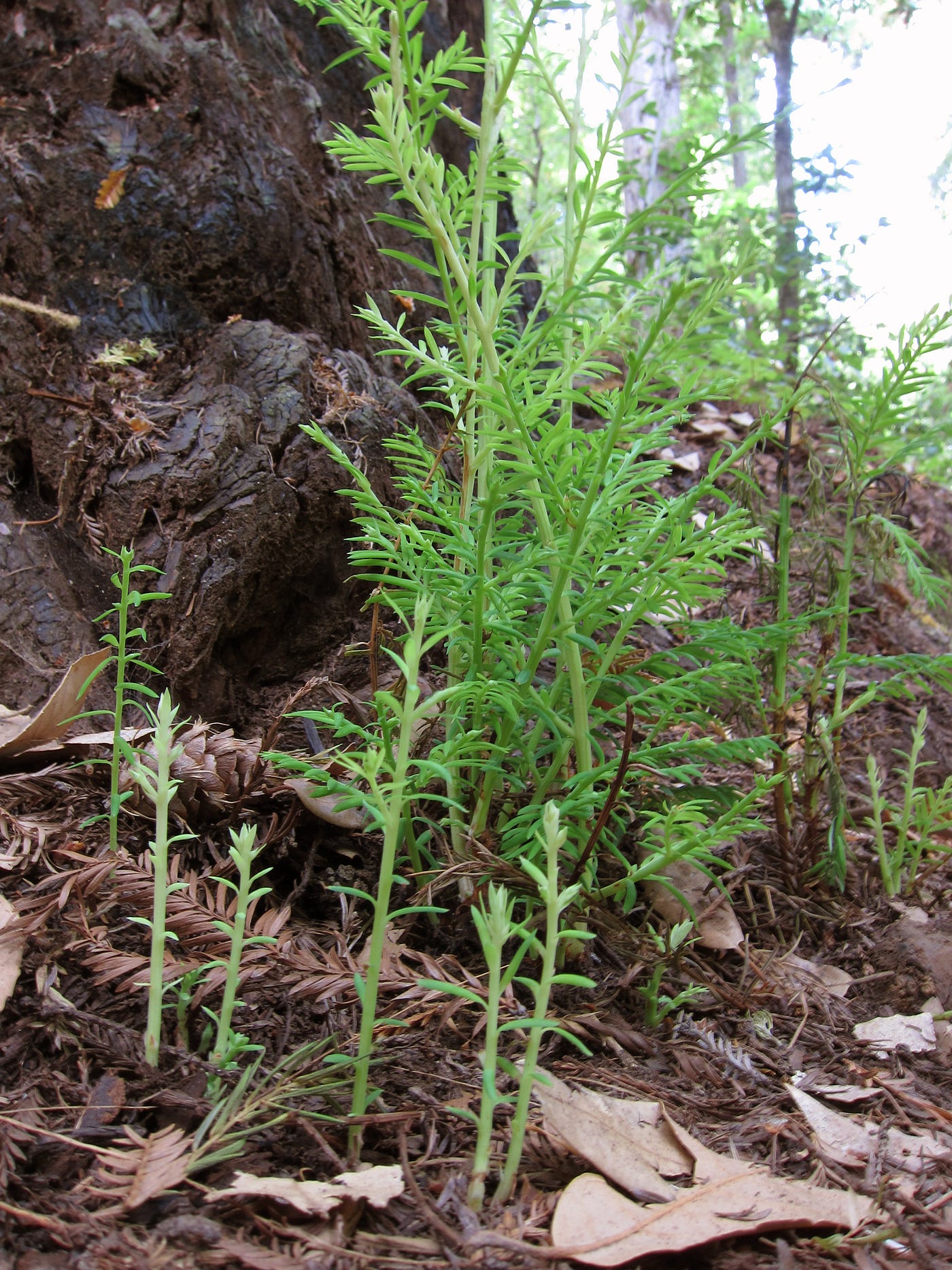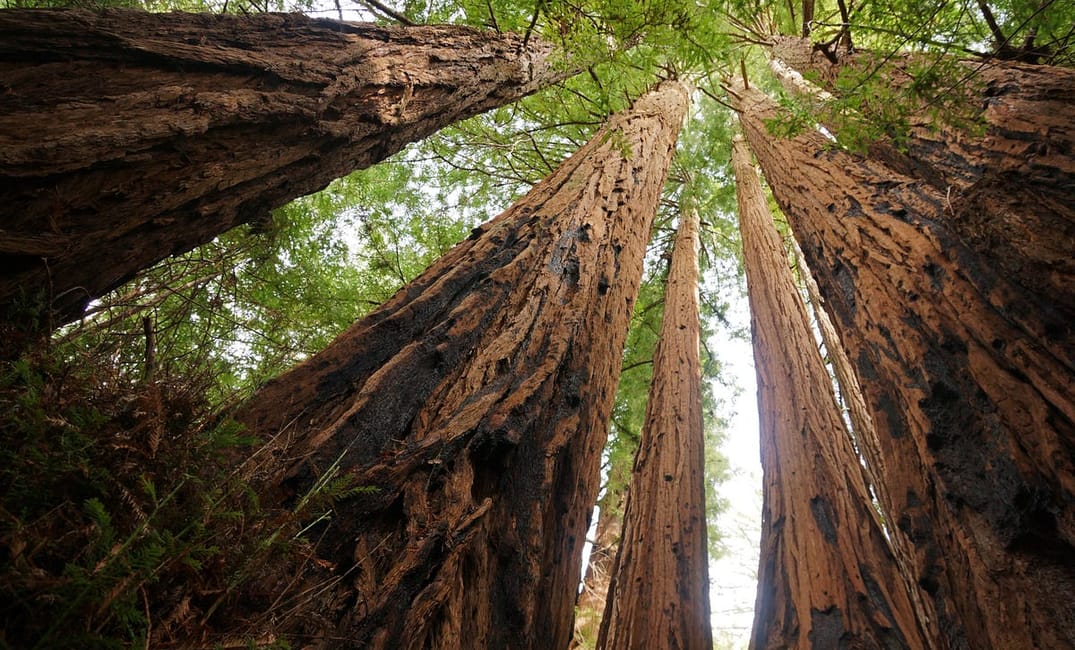
The first half of 2016 was the warmest in recorded history. The oceans are rising, glaciers are retreating, and extreme weather events have increased while the global snow cover has decreased over the past 50 years.
Yet as climate change desecrates ecosystems across the planet, the giant redwoods of the old-growth forests have been basking in the warm sunlight and may actually be thriving. Since the 1970s, some coastal redwoods have seen unprecedented growth surges — coinciding with a sharp uptick in global temperatures during the same span.
Redwoods are, as a species, more than 100 million years old and among the oldest living things on the planet. The oldest living coastal redwood tree predates the Roman Empire.Not to be confused with their massive sequoia cousins, which grow along the slopes of the Sierra Nevada mountain range, the coastal redwoods are an icon of California’s coastline.
The observation of recent growth surges despite these forests experiencing some of the highest temperatures in recent history might make you scratch your head. Could these towering trees actually be benefitting from today’s dramatic climate shifts? According to a 2015 report by professor Stephen C. Sillett, Kenneth L. Fisher Chair of Redwood Forest Ecology at Humboldt State University, a combination of three environmental changes could be linked to the growth surges over the past half century: increased sunlight thanks to the end of heavy logging in California, clean air after years of abysmal air quality, and less fog.
More carbon in the atmosphere actually helps tall trees become more water efficient — a trait that may allow them to thrive despite higher levels of atmospheric carbon.
Tall trees also thrive when there is more carbon dioxide in the atmosphere. Typically, little pores in a tree’s leaves, called stomata, open up wide to let carbon dioxide in, which the trees use to make the sugar they need to grow. When this happens, water evaporates out through a process scientists call transpiration.
When CO2 is more plentiful, Sillett explains, a tree doesn’t have to open its stomata as wide and can control its levels of transpiration. So more carbon in the atmosphere actually helps tall trees become more water efficient — a trait that may allow them to thrive despite higher levels of atmospheric carbon.

Changing more than just the climate
The outlook for the future of the redwoods is not entirely positive. According to Dr. Todd Dawson, professor of integrative biology at UC Berkeley, “Human impact on a whole — not just climate change — will change redwood forests.” Development, urbanization, invasive species, encroaching agriculture and air pollution will likely continue to hinder the growth of forests.
Dawson, a longtime student of climate change and its impact on redwood forests, emphasizes that redwood trees have the ability to naturally spread to cooler and wetter climates. That kind of natural dispersion typically takes generations, and humans have rendered it nearly impossible. “We have reconfigured the surface of the planet,” Dawson says. “Human occupation and the spread of the human population across the planet pose challenges not just for redwoods but for thousands of different organisms.” Indeed, it’s not just that the planet is warmer — after all, these trees have survived climate change before — but that today’s redwoods are simultaneously facing never-before-seen challenges like urbanization and invasive species.
“How great would it be if the redwood could survive?” asks Burns.
Dawson’s point — that there’s more to worry about than just our carbon emissions — is valid. Yet we cannot go back in time and eliminate invasive species introduced by past generations or retroactively stop the loggers of the 19th and 20th centuries. What holds for the future of the redwood forest?
Despite California’s five-year drought, northern parts of the redwood forest range have seen plentiful rainfall — even excess water in some cases, according to Emily Burns, director of science at Save the Redwoods League. “Right now the prognosis [for the redwoods’ survival] is good,” Burns says, and that means it’s important to protect and invest in these forests now. In the face of climate change and other human interferences, “How great would it be if the redwood could survive?” asks Burns.
Redwoods’ ancestors once lived throughout the entire northern hemisphere, but over time, climatic changes — drought, in particular — have caused their range to contract severely. Today that range is limited to a relatively small strip of coastline in California and Oregon.
A tree’s threshold
Sure, redwood trees have faced numerous droughts and climate changes over the course of 100 million years and have pulled through. But now that we’re facing faster-than-normal rising temperatures and a five-year drought, some scientists are wondering just how much these great trees will be able to handle. What exactly is a redwood tree’s threshold?
It’s a question Dr. Anthony Ambrose can’t answer yet but has been working on for years. Ambrose, a canopy biologist who has done extensive research on redwood forests in California, says the redwoods are a living paradox. “These trees [can] live for thousands of years,” Ambrose says, though he notes their range was once much more widespread. Indeed, redwoods’ ancestors once lived throughout the entire northern hemisphere, but over time, climatic changes — drought, in particular — have caused their range to contract severely. Today that range is limited to a relatively small strip of coastline in California and Oregon. To Ambrose, the range contraction “indicates that they are vulnerable to climate change.”
Great adaptations
Like any species, redwoods are vulnerable to dramatic shifts in their environment. But the coastal redwoods’ unique ability to adapt is nothing short of astounding.

For starters, redwoods can reproduce clonally, which means they grow sprouts on the roots, stumps or burls of older trees. This method, more than seed-filled cones, makes it easier for saplings to grow in tough conditions because they’ve already got a head start, thanks to their parents’ nutrients.
Once they develop leaves, these giants can also absorb water directly from fog, an evolutionary tactic that helps them through dry summers. Not only that, but a recent study has also shown that redwoods can absorb nitrogen and other vital nutrients through their leaves. Moreover, they have protective mechanisms to fight insects, rot and fires. The redwood tree has evolved strategies of survival that make it adept at thriving both in times of plenty and times of hardship.
Southern contraction
Despite the aforementioned adaptations, the southern edge of the redwood forest range is moving north as temperatures rise and rainfall tapers. It’s not looking good for trees in marginal areas to the south and east of the forest range. They’re dying back, canopies are thinning out, and growth has even stopped in some areas.
A recent study by Dr. Miguel Fernández predicted that in a worst-case scenario — a hot and dry future — the coastal redwood forest range could decrease by 79 percent.
The southern end of the range gets about half the rainfall that the northern, wetter part of the range gets, according to Burns. Scientists agree that the water balance of the redwood-forest ecosystem matters. To show the combined geographical impact of climate and precipitation changes, a recent study by Dr. Miguel Fernández of the German Centre for Integrative Biodiversity Research projected a number of different climate-rainfall scenarios, ranging from warmer and drier to cooler and wetter, between 2020 and 2030.
The study’s worst-case scenario (a hot and dry future) predicted that the coastal redwood forest range could decrease by 79 percent.
Fernández’s study also showed that even if rainfall continues to stay stable, rising temperatures along the California coast could decimate all suitable redwood habitats south of the San Francisco Bay.
There is a glimmer of hope in these gloomy projections. If the California coast gets cooler and wetter over the next 15 years, the area of suitable redwood habitats could actually expand by about 44 percent. If wind-related coastal upwelling continues as it is doing so now, moving the warm surface water of the Pacific Ocean aside and drawing up the cooler water underneath, this may be a possibility.
One part of a whole
When addressing the fate of the redwoods, it’s important to remember that there’s a difference between extinction and the end of the forest ecosystems, Ambrose advises. In some places where non-native redwood forests have been planted, like New Zealand and Kawaii, the trees seem to be flourishing.
Regardless of where these trees end up, they seem to need to be within a forest ecosystem in order to really thrive. Dr. Ambrose has noticed individual trees scattered throughout the city of Berkeley, for example, that seem to be drying up and dying back.
Saving the redwoods, then, becomes more than just saving the tree — we have to save the ecosystem too. And with climate change, what will be the fate of the ferns, owls, salamanders, fish and hundreds of other species that call the native redwood-forest ecosystem home? Add that question to the Things We Still Don’t Know column.
Here’s what we do know: the redwoods are not only intrinsically worth saving, but also they have a lot to give back. Jedediah Smith Redwoods State Park stores the highest amount of aboveground carbon ever recorded, at more than 2,500 metric tons of carbon per hectare. That’s three times more carbon than in any other forest on Earth.
How to save the redwoods
Despite extensive research, scientists have only just begun to understand these giants. And given that redwoods can live for thousands of years, we probably won’t live to see an impact in our lifetime.
Still, we’re making progress. There are low-tech ways to learn more about how climate change affect the redwoods, like counting the number of seedlings in a particular forest to measure new growth. And there are high-tech solutions as well, according to Dawson. “Some of the new technology that’s been rolling out over the past two to 10 years can help us see what’s happening with these trees in ways we’ve never been able to do before.” These new technologies are helping scientists gain more information, including detailed physiology of individual trees and drone-derived measurements of entire patches of forests. Among the most impressive new technologies scientists are using are remote sensors that can measure the reflectance of light off of land surfaces, and off of the trees themselves, to assess the health of the forest.
Currently, much of this research is geographically limited: most studies on the coastal redwoods are done in the healthiest parts of the range in highly protected old-growth areas. More studies of the more marginal areas of the coastal redwood range are needed, as Dr. Ambrose advocates — especially the redwood’s south range, where the forests appear to be most at risk from drought and climate change.
More research will lead to answers that could help us save and preserve the redwoods. It might also help us better understand whether they need saving at all.
Images courtesy Wikimedia Commons (CC).







